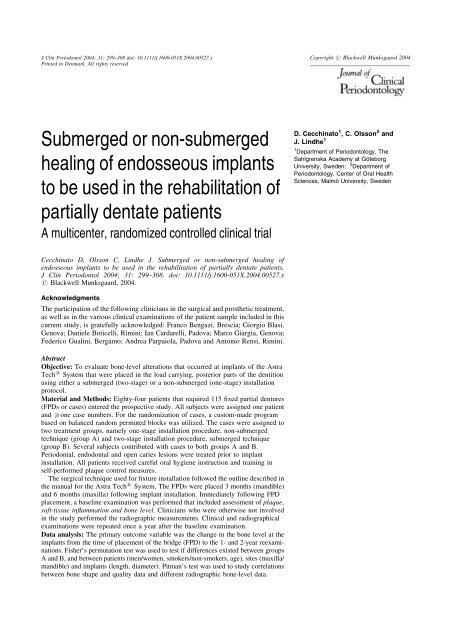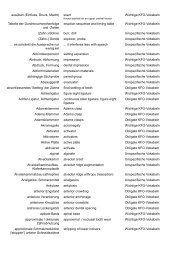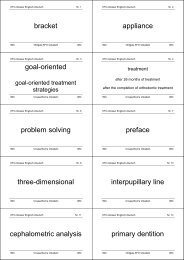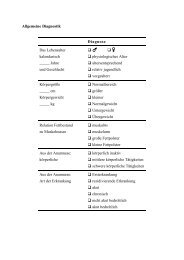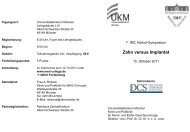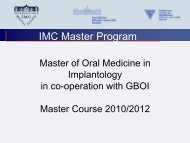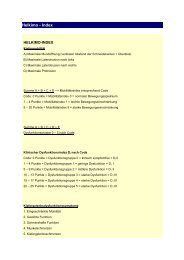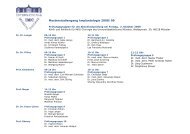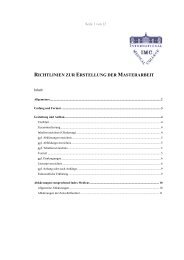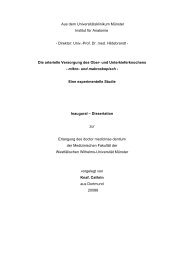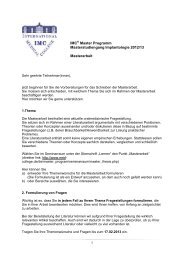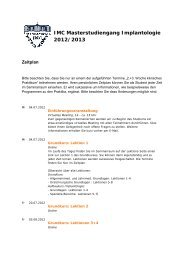Submerged or non-submerged healing of endosseous implants to ...
Submerged or non-submerged healing of endosseous implants to ...
Submerged or non-submerged healing of endosseous implants to ...
Create successful ePaper yourself
Turn your PDF publications into a flip-book with our unique Google optimized e-Paper software.
J Clin Periodon<strong>to</strong>l 2004; 31: 299–308 doi: 10.1111/j.1600-051X.2004.00527.x Copyright r Blackwell Munksgaard 2004<br />
Printed in Denmark. All rights reserved<br />
<strong>Submerged</strong> <strong>or</strong> <strong>non</strong>-<strong>submerged</strong><br />
<strong>healing</strong> <strong>of</strong> <strong>endosseous</strong> <strong>implants</strong><br />
<strong>to</strong> be used in the rehabilitation <strong>of</strong><br />
partially dentate patients<br />
A multicenter, randomized controlled clinical trial<br />
Cecchina<strong>to</strong> D, Olsson C, Lindhe J. <strong>Submerged</strong> <strong>or</strong> <strong>non</strong>-<strong>submerged</strong> <strong>healing</strong> <strong>of</strong><br />
<strong>endosseous</strong> <strong>implants</strong> <strong>to</strong> be used in the rehabilitation <strong>of</strong> partially dentate patients.<br />
J Clin Periodon<strong>to</strong>l 2004; 31: 299–308. doi: 10.1111/j.1600-051X.2004.00527.x<br />
r Blackwell Munksgaard, 2004.<br />
Acknowledgments<br />
The participation <strong>of</strong> the following clinicians in the surgical and prosthetic treatment,<br />
as well as in the various clinical examinations <strong>of</strong> the patient sample included in this<br />
current study, is gratefully acknowledged: Franco Bengazi, Brescia; Gi<strong>or</strong>gio Blasi,<br />
Genova; Daniele Boticelli, Rimini; Ian Cardarelli, Padova; Marco Giargia, Genova;<br />
Federico Gualini, Bergamo; Andrea Parpaiola, Padova and An<strong>to</strong>nio Rensi, Rimini.<br />
Abstract<br />
Objective: To evaluate bone-level alterations that occurred at <strong>implants</strong> <strong>of</strong> the Astra<br />
Tech s System that were placed in the load carrying, posteri<strong>or</strong> parts <strong>of</strong> the dentition<br />
using either a <strong>submerged</strong> (two-stage) <strong>or</strong> a <strong>non</strong>-<strong>submerged</strong> (one-stage) installation<br />
pro<strong>to</strong>col.<br />
Material and Methods: Eighty-four patients that required 115 fixed partial dentures<br />
(FPDs <strong>or</strong> cases) entered the prospective study. All subjects were assigned one patient<br />
and Xone case numbers. F<strong>or</strong> the randomization <strong>of</strong> cases, a cus<strong>to</strong>m-made program<br />
based on balanced random permuted blocks was utilized. The cases were assigned <strong>to</strong><br />
two treatment groups, namely one-stage installation procedure, <strong>non</strong>-<strong>submerged</strong><br />
technique (group A) and two-stage installation procedure, <strong>submerged</strong> technique<br />
(group B). Several subjects contributed with cases <strong>to</strong> both groups A and B.<br />
Periodontal, endodontal and open caries lesions were treated pri<strong>or</strong> <strong>to</strong> implant<br />
installation. All patients received careful <strong>or</strong>al hygiene instruction and training in<br />
self-perf<strong>or</strong>med plaque control measures.<br />
The surgical technique used f<strong>or</strong> fixture installation followed the outline described in<br />
the manual f<strong>or</strong> the Astra Tech s System. The FPDs were placed 3 months (mandible)<br />
and 6 months (maxilla) following implant installation. Immediately following FPD<br />
placement, a baseline examination was perf<strong>or</strong>med that included assessment <strong>of</strong> plaque,<br />
s<strong>of</strong>t-tissue inflammation and bone level. Clinicians who were otherwise not involved<br />
in the study perf<strong>or</strong>med the radiographic measurements. Clinical and radiographical<br />
examinations were repeated once a year after the baseline examination.<br />
Data analysis: The primary outcome variable was the change in the bone level at the<br />
<strong>implants</strong> from the time <strong>of</strong> placement <strong>of</strong> the bridge (FPD) <strong>to</strong> the 1- and 2-year reexaminations.<br />
Fisher’s permutation test was used <strong>to</strong> test if differences existed between groups<br />
A and B, and between patients (men/women, smokers/<strong>non</strong>-smokers, age), sites (maxilla/<br />
mandible) and <strong>implants</strong> (length, diameter). Pitman’s test was used <strong>to</strong> study c<strong>or</strong>relations<br />
between bone shape and quality data and different radiographic bone-level data.<br />
D. Cecchina<strong>to</strong> 1 , C. Olsson 2 and<br />
J. Lindhe 1<br />
1<br />
Department <strong>of</strong> Periodon<strong>to</strong>logy, The<br />
Sahlgrenska Academy at Göteb<strong>or</strong>g<br />
University, Sweden; 2 Department <strong>of</strong><br />
Periodon<strong>to</strong>logy, Center <strong>of</strong> Oral Health<br />
Sciences, Malmö University, Sweden
300 Cecchina<strong>to</strong> et al.<br />
Results: It was demonstrated that tissue <strong>healing</strong> following implant installation<br />
appeared <strong>to</strong> be independent <strong>of</strong> the surgical pro<strong>to</strong>col, i.e. whether the marginal p<strong>or</strong>tions<br />
<strong>of</strong> the <strong>implants</strong> during surgery were fully <strong>or</strong> only partly <strong>submerged</strong> under the ridge<br />
mucosa. Thus, (i) in both treatment groups the number <strong>of</strong> <strong>implants</strong> that failed <strong>to</strong><br />
osseointegrate (early failures) was small (o2%); (ii) at the end <strong>of</strong> the recommended<br />
periods <strong>of</strong> bone <strong>healing</strong> pri<strong>or</strong> <strong>to</strong> loading, – in both groups, maxilla 5 6 months and<br />
mandible 5 3 months – the level <strong>of</strong> the marginal bone was close <strong>to</strong> the c<strong>or</strong>onal rim <strong>of</strong><br />
the fixture; group A: 1.54 0.92 mm, group B: 1.31 0.77 mm. The current study<br />
also demonstrated that irrespective <strong>of</strong> surgical pro<strong>to</strong>col (two-stage, one-stage),<br />
<strong>implants</strong> supp<strong>or</strong>ting the FPDs exhibited only small amount <strong>of</strong> radiographic bone loss<br />
during the first year <strong>of</strong> function (group A: 0.02 038 mm, group B: 0.17 0.64 mm).<br />
M<strong>or</strong>eover, during the second year <strong>of</strong> function, the amount <strong>of</strong> additional bone loss that<br />
occurred in the two treatment groups was close <strong>to</strong> zero.<br />
Conclusion: Periimplant bone-level change during function seemed <strong>to</strong> be unrelated <strong>to</strong><br />
whether initial s<strong>of</strong>t- and hard-tissue <strong>healing</strong> following implant installation had<br />
occurred under <strong>submerged</strong> <strong>or</strong> <strong>non</strong>-<strong>submerged</strong> conditions.<br />
Implants made <strong>of</strong> c.p. titanium are<br />
frequently used in the rehabilitation <strong>of</strong><br />
<strong>to</strong>tally and partially edentulous patients.<br />
Findings from several retrospective but<br />
also prospective clinical studies have<br />
documented that this kind <strong>of</strong> rehabilitation<br />
has not only a predictable sh<strong>or</strong>tterm<br />
outcome but also a good longterm<br />
prognosis. It was further demonstrated<br />
that proper bone <strong>healing</strong>, i.e.<br />
‘‘osseointegration’’ occurred at 490%<br />
<strong>of</strong> all <strong>of</strong> inserted <strong>implants</strong> and that the<br />
bone tissue at most implant sites<br />
remained unchanged with respect <strong>to</strong><br />
both quality and quantity over time<br />
(f<strong>or</strong> review see Cochran 1996, Esposi<strong>to</strong><br />
et al. 1998a, b).<br />
A two-stage surgical technique was<br />
<strong>or</strong>iginally advocated in <strong>or</strong>der <strong>to</strong> optimize<br />
the process <strong>of</strong> new bone f<strong>or</strong>mation<br />
and remodeling following implant installation<br />
(Bra˚nemark et al. 1977). In<br />
the first stage, the implant was following<br />
the ostec<strong>to</strong>my procedure carefully<br />
inserted in the bone housing and <strong>submerged</strong><br />
beneath the mucosa. After a<br />
<strong>healing</strong> period <strong>of</strong> about 3–6 months, the<br />
marginal part <strong>of</strong> the fixture was exposed<br />
and abutment connection perf<strong>or</strong>med.<br />
The predictable outcome <strong>of</strong> this twostage<br />
installation technique was verified<br />
in several clinical trials that rep<strong>or</strong>ted<br />
high success and survival rates f<strong>or</strong><br />
<strong>implants</strong> that were initially <strong>submerged</strong><br />
(f<strong>or</strong> review see Esposi<strong>to</strong> et al. 1998a, b).<br />
In subsequent studies, however, it<br />
was recognized that proper osseointegration<br />
and subsequent good long-term<br />
success could be obtained also with<br />
<strong>non</strong>-<strong>submerged</strong> <strong>implants</strong>, either onepiece<br />
<strong>implants</strong> (ITI s System; Straumann<br />
AG, Waldenburg, Switzerland) <strong>or</strong><br />
two-piece <strong>implants</strong> (e.g. Bra˚nemark s<br />
System; Nobel Biocare, Göteb<strong>or</strong>g, Sweden,<br />
3I s System; Implant Innovations,<br />
Wets Palm Beach, FL, USA) that were<br />
installed in a one-stage procedure (e.g.<br />
Ericsson et al. 1996, 1997, Collaert &<br />
De Bruyn 1998, Cochran 2000).<br />
Abrahamsson et al. (1996) in a beagle<br />
dog experiment studied the marginal<br />
periimplant tissues at one <strong>non</strong>-<strong>submerged</strong><br />
(ITI s – solid screw) and two<br />
<strong>submerged</strong> implant systems (Bra˚nemark s<br />
System; Astra Tech s Implant System,<br />
Astra Tech, Mölndal, Sweden). The<br />
auth<strong>or</strong>s rep<strong>or</strong>ted that the degree <strong>of</strong><br />
‘‘bone-<strong>to</strong>-implant contact’’ as well as<br />
the dimension <strong>of</strong> various components in<br />
the periimplant mucosa following <strong>healing</strong><br />
was similar around all three implant<br />
systems studied. In a second dog study,<br />
Abrahamsson et al. (1999) compared<br />
the mucosa and the bone tissue surrounding<br />
<strong>implants</strong> <strong>of</strong> the Astra Tech s<br />
System that had been installed either in<br />
a one- (<strong>non</strong>-<strong>submerged</strong>) <strong>or</strong> a two-stage<br />
(<strong>submerged</strong>) surgical procedure. It was<br />
observed that parameters such as the<br />
length <strong>of</strong> the barrier epithelium <strong>of</strong> the<br />
periimplant mucosa, the height <strong>of</strong> the<br />
zone <strong>of</strong> connective tissue integration,<br />
the level <strong>of</strong> the marginal bone and the<br />
density <strong>of</strong> bone between threads were<br />
almost identical in the two experimental<br />
groups at the end <strong>of</strong> the <strong>healing</strong> period.<br />
In various review articles (e.g. van<br />
Steenberge et al. 1999, Berglundh et al.<br />
2002) it was concluded that implant<br />
failures were m<strong>or</strong>e frequent (i) in the<br />
maxilla than in the mandible and (ii) in<br />
the posteri<strong>or</strong> segments <strong>of</strong> the dentition<br />
than in the anteri<strong>or</strong> parts. It was<br />
suggested that the reason(s) f<strong>or</strong> these<br />
differences in treatment outcome was<br />
related <strong>to</strong> the quality <strong>of</strong> bone tissue in<br />
various regions <strong>of</strong> the alveolar processes<br />
and <strong>to</strong> the amount and direction <strong>of</strong> load<br />
that was distributed <strong>to</strong> the <strong>implants</strong><br />
during function.<br />
Key w<strong>or</strong>ds: bone quality; gender; mandible;<br />
maxilla; <strong>non</strong>-<strong>submerged</strong>; periimplant bone<br />
loss; <strong>submerged</strong><br />
Accepted f<strong>or</strong> publication 13 June 2003<br />
The objective <strong>of</strong> the current prospective<br />
study was <strong>to</strong> evaluate bone-level<br />
alterations that occurred at <strong>implants</strong> <strong>of</strong><br />
the Astra Tech s System that were<br />
placed in the load-carrying, posteri<strong>or</strong><br />
parts <strong>of</strong> the dentition using either a<br />
<strong>submerged</strong> (two-stage) <strong>or</strong> a <strong>non</strong>-<strong>submerged</strong><br />
(one-stage) installation pro<strong>to</strong>col.<br />
Material and Methods<br />
A parallel group, randomized, multicenter<br />
and controlled study was designed<br />
<strong>to</strong> determine if a difference<br />
existed between the outcome <strong>of</strong> treatment<br />
when <strong>implants</strong> <strong>of</strong> the Astra Techs System were installed acc<strong>or</strong>ding <strong>to</strong> a<br />
one- <strong>or</strong> a two-stage pro<strong>to</strong>col. The investigation<br />
was perf<strong>or</strong>med at one university<br />
clinic in Sweden and five<br />
affiliated clinical research centers (private<br />
<strong>of</strong>fices) in Italy. In each center, the<br />
clinician and the examiner were the same<br />
person. The centers were connected with<br />
a monit<strong>or</strong>ing facility at the Department<br />
<strong>of</strong> Periodon<strong>to</strong>logy, Göteb<strong>or</strong>g University.<br />
The study pro<strong>to</strong>col was approved by the<br />
regional human review board.<br />
An investigat<strong>or</strong>s meeting was arranged<br />
pri<strong>or</strong> <strong>to</strong> the start <strong>of</strong> patient<br />
recruitment. Following a screening examination,<br />
subjects who met the inclusion<br />
criteria (see below) were following<br />
inf<strong>or</strong>med consent entered in<strong>to</strong> the study,<br />
registered and randomly assigned (central<br />
monit<strong>or</strong> unit) <strong>to</strong> treatment group.<br />
Subject sample<br />
Inclusion/exclusion criteria<br />
A subject <strong>to</strong> be included in the study must<br />
be between 25 and 75 years <strong>of</strong> age,<br />
be in good general health,
not be on any medication <strong>or</strong> use any<br />
drug that, acc<strong>or</strong>ding <strong>to</strong> the responsible<br />
clinician, could jeopardize<br />
treatment outcome,<br />
not exhibit signs <strong>of</strong> untreated periodontitis<br />
<strong>or</strong> other mucosal and bone<br />
tissue lesions,<br />
not be a heavy clencher <strong>or</strong> bruxer,<br />
be partially edentulous in the posteri<strong>or</strong><br />
segments <strong>of</strong> the maxilla <strong>or</strong> the<br />
mandible,<br />
have sufficient amount <strong>of</strong> bone<br />
(X9 mm) in the recipient sites <strong>to</strong><br />
allow implant installation without<br />
the implementation <strong>of</strong> ridge augmentation<br />
procedures.<br />
One-hundred partially edentulous<br />
subjects that (i) required at least one<br />
fixed partial denture (FPD) in the<br />
posteri<strong>or</strong> segments <strong>of</strong> the dentition and<br />
(ii) met the inclusion criteria were<br />
initially recruited f<strong>or</strong> the study.<br />
Acc<strong>or</strong>ding <strong>to</strong> the inclusion criteria, a<br />
given patient could contribute with<br />
m<strong>or</strong>e than one FPD (case). The screening<br />
examination, thus, revealed that this<br />
subject sample would provide in all 136<br />
FPDs (cases). Each eligible patient<br />
received on an individual basis a<br />
detailed case presentation that described<br />
the condition <strong>of</strong> their dentition. Inf<strong>or</strong>mation<br />
was provided regarding the<br />
objective and the design <strong>of</strong> the study.<br />
All subjects signed inf<strong>or</strong>med consent<br />
f<strong>or</strong>ms.<br />
Pri<strong>or</strong> <strong>to</strong> the pre-surgical (clinical/<br />
radiographical) examination, 16 patients<br />
rep<strong>or</strong>ted that they preferred treatment<br />
that included either removable partial<br />
dentures <strong>or</strong> <strong>to</strong>oth-supp<strong>or</strong>ted FPDs. Thus,<br />
finally 84 patients (mean age 51.6<br />
years), 48 females and 36 males entered<br />
in the prospective study (Table 1). In the<br />
final subject sample, there were 21<br />
smokers and 63 <strong>non</strong>-smokers. They<br />
provided in all 115 FPDs (cases).<br />
Each individual subject was assigned<br />
one patient and Xone case numbers.<br />
This was managed through a central<br />
registrar at Göteb<strong>or</strong>g University. F<strong>or</strong> the<br />
randomization <strong>of</strong> cases, a cus<strong>to</strong>m-made<br />
program based on balanced random<br />
permuted blocks was utilized.<br />
The cases (FPDs) were assigned <strong>to</strong><br />
two different treatment groups:<br />
(Group A) One-stage installation<br />
procedure, <strong>non</strong>-<strong>submerged</strong> technique;<br />
(Group B) two-stage installation procedure,<br />
<strong>submerged</strong> technique.<br />
Several subjects contributed with<br />
cases <strong>to</strong> both groups A and B.<br />
Pre-treatment<br />
Periodontal, endodontal and open caries<br />
lesions were treated pri<strong>or</strong> <strong>to</strong> implant<br />
installation. All patients, in addition,<br />
received careful <strong>or</strong>al hygiene instruction<br />
and training in self-perf<strong>or</strong>med plaque<br />
control measures.<br />
Implant installation<br />
The surgical treatment was perf<strong>or</strong>med<br />
under local anesthesia. One hour pri<strong>or</strong><br />
<strong>to</strong> surgery, the patient received 3 g<br />
<strong>of</strong> Amoxicillin s (Scand Pharm AB,<br />
S<strong>to</strong>ckholm, Sweden). Six hours after<br />
the completion <strong>of</strong> implant installation<br />
another 1 g <strong>of</strong> Amoxicillin was provided.<br />
The surgical technique used f<strong>or</strong><br />
fixture installation followed the outline<br />
described in the manual f<strong>or</strong> the Astra<br />
Tech s Implant System.<br />
During the surgical procedure, the<br />
shape (A–D) and quality (1–4) <strong>of</strong> the<br />
jawbone at the recipient site(s) were<br />
classified acc<strong>or</strong>ding <strong>to</strong> criteria proposed<br />
by Lekholm & Zarb (1985).<br />
Table 1. Some overall characteristics <strong>of</strong> the sample<br />
number <strong>of</strong> subjects 84 36 men, 48 women<br />
63 <strong>non</strong>-smokers, 21 smokers<br />
mean age 51.6 years<br />
number <strong>of</strong> <strong>implants</strong> installed 324 145 maxilla, 179 mandibles<br />
number <strong>of</strong> FPDs (cases) 115 50 maxilla, 65 mandible<br />
number <strong>of</strong> FPDs per patient 1 56 patients<br />
2 26<br />
3 1<br />
4 1<br />
number <strong>of</strong> <strong>implants</strong> per FPD 2 <strong>implants</strong> 28 FPDs<br />
3 83<br />
4 4<br />
FPD, fixed partial denture.<br />
Bone loss at initially <strong>non</strong>-<strong>submerged</strong> <strong>implants</strong> 301<br />
One-stage technique<br />
In sites <strong>of</strong> group A, the fixtures were<br />
installed and immediately thereafter<br />
abutment (Uni s abutment; Astra Tech s<br />
System) connection was perf<strong>or</strong>med. The<br />
s<strong>of</strong>t-tissue flaps were adjusted <strong>to</strong> the<br />
<strong>implants</strong> and sutured. The surgical<br />
wounds were closed with either interrupted<br />
<strong>or</strong> continuous sutures. The abutment<br />
p<strong>or</strong>tion <strong>of</strong> the implant was during<br />
<strong>healing</strong> exposed <strong>to</strong> the <strong>or</strong>al cavity. The<br />
sutures were removed after 1 week.<br />
Two-stage technique<br />
First procedure: In sites belonging <strong>to</strong><br />
group B, the fixtures were installed and<br />
cover screws placed. The mucosal flaps<br />
were closed with sutures and the<br />
<strong>implants</strong> were during <strong>healing</strong> fully<br />
<strong>submerged</strong>. The surgical wounds were<br />
closed with either interrupted <strong>or</strong> continuous<br />
sutures. The sutures were removed<br />
after 1 week.<br />
Second procedure: 3 months (mandible)<br />
<strong>or</strong> 6 months (maxilla) later, abutment<br />
(Uni s abutment; Astra Tech s System)<br />
connection was perf<strong>or</strong>med. The center <strong>of</strong><br />
a <strong>submerged</strong> cover screw was identified<br />
with a probe and a mucosal punch s<br />
(Astra Tech s System) was used <strong>to</strong><br />
remove the covering mucosa.<br />
Following each surgical treatment, the<br />
patients received a chl<strong>or</strong>hexidine<br />
(0.15%; Ebur s , Milan, Italy) mouthwash<br />
and were <strong>to</strong>ld <strong>to</strong> rinse with the antiseptic<br />
solution twice a day f<strong>or</strong> 10 days.<br />
In both groups, the rest<strong>or</strong>ative treatment<br />
was initiated 3 months (mandible)<br />
and 6 months (maxilla) after implant<br />
installation. The rest<strong>or</strong>ative treatment<br />
steps followed recommendations provided<br />
in the manual f<strong>or</strong> the Astra Tech s<br />
System. All FPDs were made <strong>of</strong> p<strong>or</strong>celain<br />
fused <strong>to</strong> gold and were retained<br />
with screws <strong>to</strong> the <strong>implants</strong>.<br />
Examinations<br />
Immediately following the installation<br />
<strong>of</strong> the FPD, a baseline examination was<br />
perf<strong>or</strong>med that included both clinical<br />
and radiographical measurements.<br />
Plaque<br />
At each site, the presence <strong>of</strong> plaque was<br />
sc<strong>or</strong>ed on two surfaces buccal and<br />
lingual/palatal) <strong>of</strong> the implant. The<br />
mean percentage <strong>of</strong> plaque harb<strong>or</strong>ing<br />
surfaces was calculated using the case<br />
(FPD) as the unit.
302 Cecchina<strong>to</strong> et al.<br />
S<strong>of</strong>t-tissue inflammation<br />
The presence <strong>of</strong> s<strong>of</strong>t-tissue inflammation<br />
(redness and/<strong>or</strong> bleeding) was<br />
assessed on buccal and lingual/palatal<br />
aspects <strong>of</strong> each implant. The mean<br />
percentage <strong>of</strong> inflamed sites was calculated<br />
using the case as the unit.<br />
Bone level<br />
A cus<strong>to</strong>m-made film holder was produced<br />
f<strong>or</strong> each patient and FPD site. In<br />
the radiographs, the distance between<br />
the fixture head and the apical level <strong>of</strong><br />
the marginal bone that was in contact<br />
with the implant was determined by the<br />
use <strong>of</strong> a magnifying lens ( 7) <strong>to</strong> the<br />
nearest 0.1 mm. The measurements were<br />
made at the mesial and distal aspects <strong>of</strong><br />
each fixture and the mean value f<strong>or</strong> the<br />
case calculated. The radiographic examination<br />
was perf<strong>or</strong>med at the Department<br />
<strong>of</strong> Oral and Maxill<strong>of</strong>acial Radiology, at<br />
The Sahlgrenska Academy at Göteb<strong>or</strong>g<br />
University and by experienced radiologists<br />
who were otherwise not involved in<br />
the study.<br />
Clinical and radiographical examinations<br />
were repeated once a year after the<br />
baseline examination.<br />
Data analysis<br />
The primary outcome variable was the<br />
change in the bone level at the <strong>implants</strong><br />
from the time <strong>of</strong> placement <strong>of</strong> the bridge<br />
(FPD) <strong>to</strong> the 1- and 2-year reexaminations.<br />
In the comparison between groups<br />
A and B, a given subject/patient treated<br />
with 41 FPD could contribute <strong>to</strong> any <strong>of</strong><br />
the two groups with m<strong>or</strong>e than one case.<br />
In such a situation, the mean bone-level<br />
change f<strong>or</strong> the patient and group was<br />
calculated.<br />
F<strong>or</strong> description <strong>of</strong> the data, mean<br />
values and standard deviations were<br />
calculated.<br />
Fisher’s permutation test (Bradley<br />
1968) was used <strong>to</strong> test if differences<br />
existed between groups A and B, and<br />
between patients (men/women, smokers/<strong>non</strong>-smokers,<br />
age), sites (maxilla/<br />
mandible) and <strong>implants</strong> (length, diameter).<br />
Pitman’s test (Bradley 1968)<br />
was used <strong>to</strong> study c<strong>or</strong>relations between<br />
bone shape and quality data and different<br />
radiographic bone-level data. Both<br />
tests are <strong>non</strong>-parameteric and po0.05<br />
was considered <strong>to</strong> be significant.<br />
Results<br />
Table 1 presents some overall characteristics<br />
<strong>of</strong> the subject sample. Of the 84<br />
Table 2. Characteristics <strong>of</strong> the implant supp<strong>or</strong>ted fixed partial dentures (FPDs <strong>or</strong> cases) that was<br />
placed in groups A and B<br />
Group A Group B<br />
Number <strong>of</strong> FPDs 55 60<br />
Jaw (maxilla/mandible) 23/32 27/33<br />
Number <strong>of</strong> <strong>implants</strong>/FPD 2.8 2.9<br />
Number <strong>of</strong> <strong>implants</strong> 3.5/4.0 106/47 114/57<br />
Mean length <strong>of</strong> <strong>implants</strong> (mm) 11.8 11.7<br />
Frequency <strong>of</strong><br />
8–9 mm 46 52<br />
11–13 mm 76 84<br />
X15 mm 31 35<br />
Number <strong>of</strong> <strong>implants</strong> in position<br />
14, 15, 24, 25 41 48 5 89<br />
34, 35, 44, 45 33 43 5 76<br />
16, 17, 26, 27 19 23 5 42<br />
36, 37, 46, 47 55 46 5 101<br />
patients that entered in<strong>to</strong> the study, 48<br />
were women and 36 were men. Their<br />
mean age was 51.6 years; 63 were <strong>non</strong>smokers<br />
and 21 smokers. Three hundred<br />
and twenty-four <strong>implants</strong> were placed,<br />
145 in the maxilla and 179 in the<br />
mandible. One hundred and fifteen<br />
screw-retained FPDs (cases) were inserted,<br />
50 in the maxilla and 65 in the<br />
mandible. Fifty-six patients contributed<br />
with one FPD, 26 patients with two<br />
FPDs, one patient with three and one<br />
patient with four FPDs. Further, 28<br />
FPDs were supp<strong>or</strong>ted by two <strong>implants</strong>,<br />
83 FPDs with three <strong>implants</strong> and four<br />
FPDs by four <strong>implants</strong>.<br />
Table 2 describes some additional<br />
characteristics <strong>of</strong> groups A (one-stage<br />
pro<strong>to</strong>col) and B (two-stage pro<strong>to</strong>col).<br />
The number <strong>of</strong> FPDs in groups A and B<br />
were 55 and 60, respectively. In group<br />
A, there were 23 FPDs in the maxilla<br />
and 32 in the mandible. The c<strong>or</strong>responding<br />
numbers f<strong>or</strong> group B were 27 and<br />
33. The mean number <strong>of</strong> <strong>implants</strong> per<br />
FPD was 2.8 in group A and 2.9 in<br />
group B.<br />
In both groups, the maj<strong>or</strong>ity <strong>of</strong> the<br />
<strong>implants</strong> used had a diameter <strong>of</strong> 3.5 mm;<br />
group A: 106 out <strong>of</strong> 153, group B: 114<br />
out <strong>of</strong> 171.<br />
Ninety-eight <strong>of</strong> the <strong>implants</strong> placed<br />
were 8–9 mm long (46 in group A and<br />
52 in group B), 160 were 11–13 mm<br />
long (76 in group A and 84 in group B)<br />
and 66 <strong>implants</strong> (31 in group A and 35<br />
in group B) were X15 mm in length.<br />
Three hundred and eight <strong>of</strong> the 324<br />
<strong>implants</strong> used in the current study were<br />
placed in positions distal <strong>of</strong> the canine<br />
<strong>to</strong>oth regions. In the pre-molar region,<br />
there were 89 <strong>implants</strong> (41 in group A<br />
and 48 in group B) in the maxilla and 76<br />
(33 in group A and 43 in group B) in the<br />
mandible. In the molar regions, there<br />
were 42 <strong>implants</strong> installed in the maxilla<br />
(19 and 23 in groups A and B) and<br />
101 (55 in group A and 46 in group B)<br />
in the mandible.<br />
Following placement, 14 fixtures in<br />
group A and 10 fixtures in group B were<br />
by the surgeons sc<strong>or</strong>ed as having<br />
reduced ‘‘initial stability’’.<br />
Failures and dropouts<br />
Seven <strong>implants</strong> (four in group A and<br />
three in group B) failed <strong>to</strong> integrate<br />
during the process <strong>of</strong> <strong>healing</strong>. Five <strong>of</strong><br />
the seven early failures (three in group<br />
A and two in group B) were found<br />
among the 24 fixtures that following<br />
insertion exhibited a reduced ‘‘initial<br />
stability’’.<br />
All seven failures were identified<br />
pri<strong>or</strong> <strong>to</strong> FPD placement and removed.<br />
At four sites with such early failures,<br />
new <strong>implants</strong> were installed and FPDs<br />
placed acc<strong>or</strong>ding <strong>to</strong> pro<strong>to</strong>col.<br />
Table 3 describes the number <strong>of</strong><br />
<strong>implants</strong> (and FPDs) present at the time<br />
<strong>of</strong> bridge insertion (baseline) and at the<br />
two annual follow-up examinations.<br />
During the first year <strong>of</strong> function, one<br />
FPD, supp<strong>or</strong>ted by two <strong>implants</strong>, was<br />
lost <strong>to</strong> follow-up in group B. During the<br />
second 12-month interval, three FPDs<br />
(nine <strong>implants</strong>) were lost <strong>to</strong> follow-up in<br />
group B and one FPD with three<br />
<strong>implants</strong> in group A.<br />
Thus, 14 <strong>implants</strong> were lost <strong>to</strong><br />
follow-up during the 2 years <strong>of</strong> monit<strong>or</strong>ing;<br />
three in group A and 11 in group B<br />
and. In group A, all three <strong>implants</strong> that<br />
could not be accounted f<strong>or</strong> occurred in<br />
the maxilla. In group B, three <strong>of</strong> the
unaccounted <strong>implants</strong> had been placed<br />
in the maxilla and eight in the mandible.<br />
Radiographic bone-level change<br />
Overall<br />
The mean overall radiographic bone<br />
level was at baseline located a distance<br />
<strong>of</strong> 1.46 0.92 mm apical <strong>of</strong> a fixed<br />
reference level in the marginal p<strong>or</strong>tion<br />
<strong>of</strong> the fixture part <strong>of</strong> the <strong>implants</strong>.<br />
During the course <strong>of</strong> the first 24 months<br />
following the installation <strong>of</strong> the FPDs<br />
there was a small amount <strong>of</strong> bone<br />
supp<strong>or</strong>t that was lost (Table 4). This<br />
reduction <strong>of</strong> the periimplant bone level<br />
amounted <strong>to</strong> 0.08 0.47 mm during<br />
Table 3. Reason f<strong>or</strong> loss <strong>of</strong> <strong>implants</strong> (FPDs) at follow-up examinations<br />
Number <strong>of</strong> <strong>implants</strong><br />
Failure Lost <strong>to</strong> follow-up<br />
At implant placement 324<br />
At FPD placement 321 7 ( 4 5 3)<br />
At follow-up Total (A/B)<br />
1 year 319 (167/152) 2<br />
307 (158/149) 12<br />
Number <strong>of</strong> FPDs<br />
Group A Group B<br />
At FPD placement <strong>to</strong>tal 55 60<br />
maxilla 23 27<br />
mandible 32 33<br />
At follow-up<br />
1 year <strong>to</strong>tal 55 59<br />
maxilla 23 27<br />
mandible 32 32 ( 1)<br />
2 years <strong>to</strong>tal 54 56<br />
maxilla 22 ( 1) 26 ( 1)<br />
mandible 32 30 ( 2)<br />
FPD, fixed partial denture.<br />
year 1 and 0.06 0.57 mm in the<br />
interval between baseline and the 2-year<br />
follow-up examination. In the interval<br />
between 12 and 24 months, there was a<br />
small gain <strong>of</strong> bone.<br />
The bar charts in Fig. 1 illustrate the<br />
frequency <strong>of</strong> FPDs (cases) that exhibited<br />
varying amounts <strong>of</strong> bone loss<br />
during (i) year one (Fig. 1a) and (ii)<br />
years 1 and 2 (Fig. 1b) <strong>of</strong> function. In<br />
the first interval (year 1) the maj<strong>or</strong>ity <strong>of</strong><br />
the FPDs exhibited bone-level alteration<br />
within the 10.3 mm and 0.3 mm<br />
range. The group <strong>of</strong> <strong>implants</strong> that<br />
supp<strong>or</strong>ted two <strong>of</strong> the FPDs had gained<br />
on the average 1.2 and 1.1 mm bone,<br />
respectively, while the group <strong>of</strong> <strong>implants</strong><br />
in another three <strong>of</strong> the FPDs had<br />
suffered on the average 1.7, 1.9 and<br />
2.0 mm bone loss. In the interval<br />
between baseline and 24 months (i) the<br />
maj<strong>or</strong>ity <strong>of</strong> the FPDs (n 5 78) had<br />
experienced bone-level alterations between<br />
10.4 mm (six cases) and –<br />
0.5 mm (five cases). It was further<br />
observed that five FPDs appeared <strong>to</strong><br />
have improved the periimplant bone<br />
level with X0.6 mm while three FPDs<br />
had lost X1.8 mm. Fig. 2 presents the<br />
frequency <strong>of</strong> <strong>implants</strong> that gained <strong>or</strong> lost<br />
<strong>implants</strong> during the first and second<br />
years <strong>of</strong> function. While the maj<strong>or</strong>ity <strong>of</strong><br />
implant sites appeared <strong>to</strong> gain some<br />
bone during this interval seven sites<br />
(2.1%) exhibited a reduction <strong>of</strong> the bone<br />
level that amounted <strong>to</strong> 41.5 mm.<br />
Table 4. Periimplant bone-level change (mm) that occurred between baseline (BL) and 12 months and between BL and the 24-month<br />
reexamination<br />
BL–12 months BL–24 months p-value<br />
Overall 0.08 0.47 0.06 0.57<br />
Gender (men/women) 0.06 0.42/0.18 0.52 0.04 0.52/0.22 0.62 0.30, 0.16<br />
Maxilla/mandible 0.17 0.61/0.06 0.034 0.11 0.67/0.11 0.53 40.30, 40.30<br />
Non-smokers/smokers 0.18 0.51/10.04 0.28 0.22 0.62/10.09 0.42 0.046, 0.036<br />
Age<br />
o40 0.48 0.80 0.61 0.87<br />
40–60 0.11 0.40 0.10 0.52<br />
460 10.04 0.42 10.03 0.52 0.010<br />
Implant diameter<br />
3.5 mm 0.17 0.5 0.19 0.6<br />
4.0 mm 0.05 0.4 10.05 0.6 0.07<br />
Bone shape (A, B, C, D)<br />
A 0.08 0.21 0.11 0.5<br />
B 0.11 0.44 0.08 0.6<br />
C 0.15 0.62 0.17 0.71<br />
D 0.12 0.19 0.17 0.15 40.30<br />
Bone quality<br />
1 10.02 0.09 0.04 0.19<br />
2 0.14 0.71 0.14 0.76<br />
3 0.11 0.44 0.02 0.58<br />
4 0.34 0.35 0.53 0.38 40.30<br />
Numbers presented in bold indicate that a gain <strong>of</strong> the periimplant bone level had occurred.<br />
Bone loss at initially <strong>non</strong>-<strong>submerged</strong> <strong>implants</strong> 303
304 Cecchina<strong>to</strong> et al.<br />
Fig. 1. Bar chart that describes the frequency <strong>of</strong> fixed partial dentures (FPDs) that, during the<br />
first (baseline – 12 months; a) and second (baseline – 24 months; b) examination intervals,<br />
lost <strong>or</strong> gained periimplant bone. Only three cases exhibited a periimplant bone-level change<br />
that was 41.5 mm.<br />
The amount <strong>of</strong> bone-level reduction<br />
(Table 4) appeared <strong>to</strong> be larger in<br />
women than in men (0.22 versus 0.04;<br />
p40.05), and m<strong>or</strong>e pronounced in<br />
younger (o40 years) than in older<br />
(460 years) subjects. The analysis<br />
revealed that in this sample there was<br />
a significant c<strong>or</strong>relation between age<br />
and bone-level change.<br />
In the first examination interval, i.e.<br />
baseline <strong>to</strong> 12 months there was three<br />
times as much periimplant bone loss at<br />
<strong>implants</strong> in the maxilla as in the<br />
mandible (0.17 mm versus 0.06 mm;<br />
p40.05). This difference was not<br />
observed when the baseline–24-month<br />
alterations was considered.<br />
Implants with the larger diameter<br />
(4.0 mm) experienced during the 24month<br />
interval some periimplant bonelevel<br />
gain (10.05 mm) while <strong>implants</strong><br />
with the smaller diameter (3.5 mm) had<br />
experienced some loss (0.19 mm;<br />
po0.05; Table 4).<br />
The amount <strong>of</strong> periimplant bone loss<br />
that occurred at <strong>implants</strong> <strong>of</strong> varying<br />
length was also determined. Pitman’s<br />
test demonstrated that there was no<br />
c<strong>or</strong>relation (p40.30) between fixture<br />
length (8 mm–19 mm), the bone level at<br />
baseline and bone-level change over<br />
time, i.e. baseline – 12 months and<br />
baseline – 24 months.<br />
Bone-level alterations at <strong>implants</strong><br />
placed in differently shaped recipient<br />
sites with different quality <strong>of</strong> the bone<br />
tissue (Lekholm & Zarb 1985) were<br />
assessed f<strong>or</strong> different FPDs (Table 4). In<br />
both the first and second examination<br />
intervals, FPDs placed in quality 4 bone<br />
appeared <strong>to</strong> have lost m<strong>or</strong>e marginal<br />
bone than FPDs retained in sites that<br />
sc<strong>or</strong>ed quality 1, 2 <strong>or</strong> 3. Pitman’s test<br />
disclosed that there was no overall<br />
c<strong>or</strong>relation (p40.30) between bone<br />
quality and bone-level change over<br />
time. A further analysis revealed, however,<br />
that the bone-level change in both<br />
the first and the second examination<br />
intervals was significantly larger<br />
(po0.05; Fisher’s permutation test)<br />
than at <strong>implants</strong> placed in quality 4<br />
bone than at sites with dense bone<br />
(quality 1).<br />
Groups A and B (Table 5): Both in<br />
groups A and B, the <strong>implants</strong> supp<strong>or</strong>ting<br />
the FPDs experienced some periimplant<br />
bone loss during the 2 years <strong>of</strong> monit<strong>or</strong>ing.<br />
In both groups, this bone-level<br />
change occurred during the first 12<br />
months <strong>of</strong> function; 0.02 mm in group<br />
A and 0.17 mm in group B. The large<br />
standard deviations (0.38 and 0.51 mm)<br />
indicated that the bone-level change<br />
varied considerably between cases in<br />
both groups A and B. The difference<br />
between the groups with respect <strong>to</strong><br />
bone-level change in the two examination<br />
intervals was not statistically significant.<br />
The bar chart in Fig. 3<br />
describes the frequency <strong>of</strong> FPDs that<br />
exhibited varying degree <strong>of</strong> bone gain<br />
and loss during the first (Fig. 3a) and<br />
second (Fig. 3b) examination intervals.<br />
In the first interval, the maj<strong>or</strong>ity <strong>of</strong> the<br />
FPDs exhibited a bone-level change that<br />
varied between 10.2 and 0.3 mm.<br />
Three FPDs, two from group B and<br />
one from group A had experienced<br />
41.5 mm bone loss. In the second<br />
interval, the maj<strong>or</strong>ity <strong>of</strong> FPDs exhibited<br />
a bone-level change that varied between<br />
10.6 an –0.5 mm with six FPDs (four<br />
from group B and two from group A)<br />
exhibiting a bone loss <strong>of</strong> 41.2 mm.<br />
Three FPDs (two from group A and<br />
one from group B) exhibited a bonelevel<br />
reduction <strong>of</strong> X1.7 mm.<br />
Table 6 p<strong>or</strong>trays the outcome <strong>of</strong><br />
treatment in groups A and B f<strong>or</strong> FPDs<br />
placed in the maxilla and in the<br />
mandible. The mean values describing<br />
bone-level change indicated that only<br />
small amounts <strong>of</strong> bone loss occurred at<br />
<strong>implants</strong> in the two jaws during<br />
the 2 years <strong>of</strong> monit<strong>or</strong>ing. Thus, the<br />
differences between the bone levels<br />
rec<strong>or</strong>ded at baseline and 24 months in<br />
the two groups amounted <strong>to</strong> 0.06 and<br />
0.15 mm (maxilla) and 0.01 and 0.22<br />
(mandible).<br />
A further analysis included FPDs that<br />
exclusively were supp<strong>or</strong>ted by <strong>implants</strong><br />
placed in the posteri<strong>or</strong> part <strong>of</strong> the<br />
dentition, distal <strong>of</strong> the canine position<br />
(Table 6). In both groups, the bone-level<br />
change f<strong>or</strong> FPDs placed in the posteri<strong>or</strong><br />
maxilla and posteri<strong>or</strong> mandible was<br />
similar.<br />
FPDs in group A exhibited less<br />
reduction <strong>of</strong> the periimplant bone level<br />
in both the first and second examination<br />
intervals than c<strong>or</strong>responding FPDs in<br />
group B. Between baseline and 2 years,<br />
FPDs in the maxilla gained 0.02<br />
0.44 mm bone, while FPDs in the same<br />
location in group B lost 0.20<br />
0.78 mm.<br />
Oral hygiene and s<strong>of</strong>t-tissue<br />
inflammation<br />
During the pre-treatment phase, all<br />
subjects included in the study had<br />
adopted proper <strong>or</strong>al hygiene habits. This<br />
is illustrated by the fact that the plaque<br />
and inflammation sc<strong>or</strong>es obtained at<br />
baseline were low, 6.6% and 3.0%,<br />
respectively (Table 7). At the reexaminations<br />
after 1 and 2 years, the sc<strong>or</strong>e<br />
values in both groups had increased <strong>to</strong><br />
levels <strong>of</strong> about 12% (plaque) and 6%<br />
(s<strong>of</strong>t-tissue inflammation).
Fig. 2. Bar chart that p<strong>or</strong>trays the number <strong>of</strong> <strong>implants</strong> that exhibited gain <strong>or</strong> loss <strong>of</strong><br />
periimplant bone height during baseline – 12 months (a) and baseline – 24 months (b). Seven<br />
<strong>implants</strong> exhibited a bone loss <strong>of</strong> 41.5 mm while seven <strong>implants</strong> gained 41 mm <strong>of</strong> bone.<br />
Table 5. Periimplant bone-level change (mm) that occurred in groups A and B between baseline<br />
(BL) and 12 months and between BL and the 24-month reexamination<br />
Treatment Group A Group B p-value<br />
BL–12 months 0.02 0.38 0.17 0.51 0.11<br />
12–24 months 0.00 0.28 0.00 0.29 0.23<br />
Discussion<br />
The findings <strong>of</strong> the present randomized<br />
controlled clinical trial demonstrated<br />
that tissue <strong>healing</strong> following implant<br />
installation appeared <strong>to</strong> be independent<br />
<strong>of</strong> the surgical pro<strong>to</strong>col, i.e. whether the<br />
marginal p<strong>or</strong>tions <strong>of</strong> the <strong>implants</strong> during<br />
surgery were fully <strong>or</strong> only partly <strong>submerged</strong><br />
under the ridge mucosa. Thus,<br />
Bone loss at initially <strong>non</strong>-<strong>submerged</strong> <strong>implants</strong> 305<br />
in both treatment groups the number <strong>of</strong><br />
<strong>implants</strong> that failed <strong>to</strong> osseointegrate<br />
(early failures) was small (o2%).<br />
Further, at the end <strong>of</strong> the recommended<br />
periods <strong>of</strong> bone <strong>healing</strong> pri<strong>or</strong> <strong>to</strong> loading<br />
– maxilla 6 months and mandible 3<br />
months – in both groups, the level <strong>of</strong> the<br />
marginal bone was close <strong>to</strong> the c<strong>or</strong>onal<br />
rim <strong>of</strong> the fixture.<br />
The current study also demonstrated<br />
that, irrespective <strong>of</strong> surgical installation<br />
pro<strong>to</strong>col (two-stage, one-stage) <strong>implants</strong><br />
supp<strong>or</strong>ting the FPDs exhibited only<br />
small amount <strong>of</strong> radiographic bone loss<br />
during the first year <strong>of</strong> function (group<br />
A: 0.02 038 mm; group B: 0.17<br />
0.64 mm). M<strong>or</strong>eover, during the second<br />
year <strong>of</strong> function, the amount <strong>of</strong> additional<br />
bone loss that occurred in the two<br />
treatment groups was close <strong>to</strong> zero.<br />
Based on the above findings there are<br />
reasons <strong>to</strong> suggest that it may be not be<br />
necessary <strong>to</strong> submerge <strong>implants</strong> <strong>of</strong> the<br />
Astra Tech s System during the initial<br />
phase <strong>of</strong> <strong>healing</strong> in <strong>or</strong>der <strong>to</strong> obtain<br />
proper s<strong>of</strong>t- and hard-tissue modeling<br />
and osseointegration.<br />
Seven <strong>implants</strong> (2.1%), four in the<br />
maxilla and three in the mandible, failed<br />
<strong>to</strong> osseointegrate during the process <strong>of</strong><br />
<strong>healing</strong>. Four <strong>of</strong> the early failures<br />
occurred in group A and three in group<br />
B. This low frequency <strong>of</strong> early failures<br />
agrees with findings from previous studies<br />
using different implant systems in<br />
fully and partially edentulous patients<br />
(e.g. Adell et al. 1990a, b, Friberg et al.<br />
1991, Becker et al. 1997, Karlsson et al.<br />
1998, van Steenberghe et al. 2000,<br />
Engquist et al. 2002; f<strong>or</strong> review see<br />
Esposi<strong>to</strong> 1999, Berglundh et al. 2002).<br />
The most imp<strong>or</strong>tant observation<br />
made in the present study was that<br />
periimplant bone-level change did not<br />
differ between groups A and B during<br />
years 1 and 2 <strong>of</strong> function. This finding is<br />
in agreement with data previously<br />
rep<strong>or</strong>ted from animal experiments (e.g.<br />
Gotfredsen et al. 1991, Abrahamsson et<br />
al. 1996, 1999, Ericsson et al. 1996,<br />
Weber et al. 1996) in which only min<strong>or</strong>,<br />
if any, differences were noted concerning<br />
amount and quality <strong>of</strong> s<strong>of</strong>t and hard<br />
tissues f<strong>or</strong>med around the titanium rods<br />
during <strong>healing</strong> between <strong>implants</strong> placed<br />
acc<strong>or</strong>ding <strong>to</strong> <strong>submerged</strong> and <strong>non</strong>-<strong>submerged</strong><br />
treatment pro<strong>to</strong>cols. The current<br />
results are also in agreement with data<br />
from prospective studies and case rep<strong>or</strong>ts<br />
in humans (e.g. Ericsson et al.<br />
1994, 1997, Henry & Rosenberg 1994,<br />
Bernard et al. 1995, Balshi & Wolfinger<br />
1997, Becker et al. 1997, 2000, Schnitman
306 Cecchina<strong>to</strong> et al.<br />
Fig. 3. Bar charts that describe the number <strong>of</strong> fixed partial dentures (FPDs) in groups A and<br />
B that presented with varying amounts <strong>of</strong> periimplant bone loss during the first 12 months (a)<br />
and in the interval between baseline and 24 months (b). Only three FPDs – one in group A<br />
and two in group B exhibited a bone-level reduction that was 41.5 mm.<br />
Table 6. Periimplant bone-level change (mm) that occurred at <strong>implants</strong> supp<strong>or</strong>ting FPDs in the<br />
maxilla and in the mandible <strong>of</strong> groups A and B between baseline (BL) and the reexaminations<br />
Maxilla p-value Mandible p-value<br />
Group A Group B Group A Group B<br />
Overall<br />
BL–12 months 0.13 0.52 0.20 0.69 40.30 10.03 0.25 0.17 0.40 0.04<br />
BL–24 months 0.06 0.58 0.15 0.74 40.30 0.01 0.45 0.22 0.59 0.18<br />
Numbers presented in bold indicate that a gain <strong>of</strong> the periimplant bone level had occurred.<br />
Table 7. Frequency distribution <strong>of</strong> plaque and inflammation sc<strong>or</strong>es obtained from the<br />
examinations at baseline and after 1 and 2 years <strong>of</strong> monit<strong>or</strong>ing<br />
Total Group A Group B p-value<br />
Plaque (%)<br />
baseline 6.6 18.8 4.7 14.5 8.4 22.3 40.30<br />
1 year 11.5 25.5 7.8 18.9 15.1 30.3 0.18<br />
2 years 12.7 23.5 11.3 21.9 14.0 25.0 40.30<br />
Inflammation (%)<br />
baseline 3.0 9.2 2.4 9.1 3.5 9.3 40.30<br />
1 year 11.6 4.8 11.1 2.9 8.0 6.7 13.2 0.12<br />
2 years 11.9 6.5 17.8 3.0 8.0 9.9 23.4 0.067<br />
et al. 1997, Tarnow et al. 1997, Randow<br />
et al. 1999) that demonstrated that the<br />
marginal bone level following rehabilitation<br />
appeared <strong>to</strong> remain stable irrespective<br />
<strong>of</strong> whether the <strong>implants</strong> had<br />
been placed acc<strong>or</strong>ding <strong>to</strong> a one- <strong>or</strong> twostep<br />
surgical pro<strong>to</strong>col.<br />
Albrektsson & Isid<strong>or</strong> (1993) in a<br />
consensus rep<strong>or</strong>t modified the <strong>or</strong>iginally<br />
proposed criteria <strong>of</strong> success f<strong>or</strong> dental<br />
implant systems (Albrektsson et al.<br />
1986) and stated that pronounced,<br />
progressive reduction <strong>of</strong> the periimplant<br />
bone level is a sign <strong>of</strong> failure <strong>of</strong> implant<br />
therapy. They suggested that criteria f<strong>or</strong><br />
success should demand ‘‘an average<br />
marginal bone loss <strong>of</strong> less than 1.5 mm<br />
during the first year’’ and thereafter<br />
o0.2 mm annual bone loss. In this<br />
context, it should be realized that in<br />
the current sample the average periimplant<br />
bone loss during the first year<br />
following the insertion <strong>of</strong> the FPDs was<br />
only 0.08 0.47 mm. The c<strong>or</strong>responding<br />
periimplant bone-level change during<br />
year 2 was close <strong>to</strong> zero. In other<br />
w<strong>or</strong>ds, the implant system used in the<br />
present multicenter study met the proposed<br />
criteria <strong>of</strong> success. The finding<br />
that only min<strong>or</strong> amounts <strong>of</strong> progressive<br />
periimplant bone loss <strong>to</strong>ok place during<br />
function (loading) in patients rest<strong>or</strong>ed<br />
with <strong>implants</strong> <strong>of</strong> the Astra Tech s<br />
System is in agreement with data<br />
rep<strong>or</strong>ted in previous clinical studies<br />
including fully and partially edentulous<br />
jaws and patients (e.g. Makkonen et al.<br />
1997, Karlsson et al. 1998, van Steenberghe<br />
et al. 2000, Steveling et al. 2001,<br />
Yi et al. 2001, Engquist et al. 2002).<br />
Albrektsson & Isid<strong>or</strong> (1993) also<br />
recommended that the frequency distribution<br />
<strong>of</strong> data should be ‘‘added <strong>to</strong><br />
the rep<strong>or</strong>ting’’. Such frequency distributions<br />
describing the cases and <strong>implants</strong><br />
in the current subject sample are<br />
presented in Figs. 1 and 2. It is obvious<br />
from the data rep<strong>or</strong>ted in the bar charts<br />
that only three cases out <strong>of</strong> 115 (2.6%)<br />
and seven <strong>implants</strong> out <strong>of</strong> 321 (2.2%)<br />
exhibited bone loss during years 1 and 2<br />
that exceeded the values included in the<br />
recommended criteria.<br />
In the present study, it was observed<br />
that <strong>implants</strong> that were placed in quality<br />
4 bone (Lekholm & Zarb 1985) during<br />
the first year <strong>of</strong> function exhibited a<br />
periimplant bone loss that amounted <strong>to</strong><br />
0.34 0.35 mm while <strong>implants</strong> placed<br />
in quality 1 bone in the same interval<br />
gained on the average 0.02 0.09 mm<br />
bone (o0.05). This observation is in<br />
agreement with, e.g. Friberg et al.<br />
(1991), Jemt (1993), Sullivan et al.<br />
(1997), who found higher failure rates<br />
f<strong>or</strong> <strong>implants</strong> placed in trabecular bone<br />
than in sites with hard tissue with larger<br />
amounts <strong>of</strong> c<strong>or</strong>tical bone. On the other<br />
hand, it should be recognized that<br />
other auth<strong>or</strong>s have failed <strong>to</strong> confirm<br />
that quality 4 bone provided po<strong>or</strong><br />
<strong>healing</strong> conditions following implant<br />
installation (Bahat 1993, Truhlar et al.<br />
1997).<br />
It has been claimed that in the fully<br />
edentulous patient rest<strong>or</strong>ed with implant<br />
wearing fixed prostheses <strong>or</strong> overdentures,<br />
progressive periimplant bonelevel<br />
reduction as well as implant loss<br />
during function was m<strong>or</strong>e frequent in<br />
the maxilla than in the mandible, while
this difference between jaws appeared<br />
not <strong>to</strong> be valid f<strong>or</strong> <strong>implants</strong> and FPDs<br />
placed in partially dentate subjects (f<strong>or</strong><br />
review see Esposi<strong>to</strong> 1999). The findings<br />
from the present follow-up examinations<br />
confirmed previous findings. Thus,<br />
in group A as well as in group B, the<br />
amount <strong>of</strong> periimplant bone-level<br />
change that occurred between baseline<br />
and year 1(2) in the maxilla as well as in<br />
the mandible was small and the difference<br />
between jaws not statistically<br />
significant.<br />
The observation that the surgical<br />
pro<strong>to</strong>col does not influence the outcome<br />
<strong>of</strong> implant therapy i.a. apparently not<br />
only <strong>to</strong> be valid f<strong>or</strong> FPD rest<strong>or</strong>ations but<br />
also f<strong>or</strong> single-<strong>to</strong>oth replacements.<br />
Thus, Ericsson et al. (2000) studied the<br />
result <strong>of</strong> single-<strong>to</strong>oth replacements in<br />
the maxillary front <strong>to</strong>oth regions <strong>of</strong><br />
<strong>implants</strong> installed acc<strong>or</strong>ding <strong>to</strong> a onestage<br />
surgical procedure in comparison<br />
with ‘‘the <strong>or</strong>iginal two-stage concept’’<br />
f<strong>or</strong> <strong>implants</strong> <strong>of</strong> the Bra˚nemark s System.<br />
The auth<strong>or</strong>s rep<strong>or</strong>ted that the<br />
periimplant bone-level change during<br />
the first year <strong>of</strong> function at <strong>implants</strong> was<br />
small and varied between 10.08 mm<br />
(loss) f<strong>or</strong> the one-stage and 0.05<br />
(gain) f<strong>or</strong> the two-stage pro<strong>to</strong>col.<br />
References<br />
Abrahamsson, I., Berglundh, T., Moon, I.-S. &<br />
Lindhe, J. (1999) Peri-implant tissues at<br />
<strong>submerged</strong> and <strong>non</strong>-<strong>submerged</strong> titanium <strong>implants</strong>.<br />
Journal <strong>of</strong> Clinical Periodon<strong>to</strong>logy<br />
26, 600–607.<br />
Abrahamsson, I., Berglundh, T., Wennström, J.<br />
& Lindhe, J. (1996) The peri-implant hard<br />
and s<strong>of</strong>t tissues at different implant systems.<br />
Clinical Oral Implants Research 7, 212–219.<br />
Adell, R., Eriksson, B., Lekholm, U., Bra˚nemark,<br />
P.-I. & Jemt, T. (1990b) A long-term<br />
follow-up study <strong>of</strong> osseointegrated <strong>implants</strong><br />
in the treatment <strong>of</strong> <strong>to</strong>tally edentulous jaws.<br />
The International Journal <strong>of</strong> Oral & Maxill<strong>of</strong>acial<br />
Implants 5, 347–359.<br />
Adell, R., Lekholm, U., Gröndahl, K., Bra˚nemark,<br />
P.-I., Lindström, J. & Jacobsson, M.<br />
(1990a) Reconstruction <strong>of</strong> severely res<strong>or</strong>bed<br />
edentulous maxillae using osseointegrated<br />
fixtures in immediate au<strong>to</strong>genous bone grafts.<br />
The International Journal <strong>of</strong> Oral & Maxill<strong>of</strong>acial<br />
Implants 5, 233–246.<br />
Albrektsson, T. & Isid<strong>or</strong>, F. (1993) Consensus<br />
rep<strong>or</strong>t: implant therapy. In: Proceedings <strong>of</strong><br />
the 1st European w<strong>or</strong>kshop on periodon<strong>to</strong><strong>to</strong>logy,<br />
eds. Lang, N. P. & Karring, T., pp.<br />
365–369. Berlin: Quintessence.<br />
Albrektsson, T., Zarb, G., W<strong>or</strong>thing<strong>to</strong>n, P. &<br />
Eriksson, A. R. (1986) The long-term<br />
efficacy <strong>of</strong> currently used dental <strong>implants</strong>: a<br />
review and proposed criteria <strong>of</strong> success. The<br />
International Journal <strong>of</strong> Oral & Maxill<strong>of</strong>acial<br />
Implants 1, 11–25.<br />
Bahat, O. (1993) Treatment planning and<br />
placement <strong>of</strong> <strong>implants</strong> in the posteri<strong>or</strong><br />
maxillae: rep<strong>or</strong>t <strong>of</strong> 732 consecutive Nobelpharma<br />
<strong>implants</strong>. The International Journal<br />
<strong>of</strong> Oral & Maxill<strong>of</strong>acial Implants 8, 151–161.<br />
Balshi, T. J. & Wolfinger, G. J. (1997)<br />
Immediate loading <strong>of</strong> Bra˚nemark <strong>implants</strong><br />
in edentulous mandibles: a preliminary<br />
rep<strong>or</strong>t. Implant Dentistry 6, 83–88.<br />
Becker, W., Becker, B. E., Israelson, H.,<br />
Lucchini, J. P., Handelsman, M., Ammons,<br />
W., Rosenberg, E., Rose, L., Tucker, L. M. &<br />
Lekholm, U. (1997) One-step surgical placement<br />
<strong>of</strong> Bra˚nemark <strong>implants</strong>: a prospective<br />
multicenter clinical study. The International<br />
Journal <strong>of</strong> Oral & Maxill<strong>of</strong>acial Implants 12,<br />
454–462.<br />
Becker, W., Becker, B. E., Ricci, A., Bahat, O.,<br />
Rosenberg, E., Rose, L. F., Handelsman, M.<br />
& Israelson, H. (2000) A prospective multicenter<br />
clinical trial comparing one- and twostage<br />
titanium screw-shaped fixtures with<br />
one-state plasma-sprayed solid-screw fixtures.<br />
Clinical Implant Dentistry and Related<br />
Research 2, 159–165.<br />
Berglundh, T., Persson, L. & Klinge, B. (2002)<br />
A systematic review <strong>of</strong> the incidence <strong>of</strong><br />
biological and technical complications in<br />
implant dentistry rep<strong>or</strong>ted in prospective<br />
longitudinal studies <strong>of</strong> at least 5 years.<br />
Journal <strong>of</strong> Clinical Periodon<strong>to</strong>logy 29<br />
(Suppl. 3), 197–212.<br />
Bernard, J.-P., Belser, U. C., Martinet, J.-P. &<br />
B<strong>or</strong>gis, S. A. (1995) Osseointegration <strong>of</strong><br />
Bra˚nemark fixtures using a single-step operating<br />
technique. A preliminary prospective<br />
one year study in the edentulous mandible.<br />
Clinical Oral Implants Research 6, 122–129.<br />
Bradley, J. W. (1968) Distribution-free statistical<br />
tests, pp. 68–86. London: Prentice–Hall.<br />
Bra˚nemark, P.-I., Hansson, B. O., Adell, R.,<br />
Breine, U., Lindström, J., Hallen, O. &<br />
Öhman, A. (1977) Osseointegrated <strong>implants</strong><br />
in the treatment <strong>of</strong> the edentulous jaw.<br />
Experience from a 10-year period. Scandinavian<br />
Journal <strong>of</strong> Plastic and Reconstructive<br />
Surgery II (Suppl. 16).<br />
Cochran, D. L. (1996) Implant therapy I. Annals<br />
<strong>of</strong> Periodon<strong>to</strong>logy 1, 707–791.<br />
Cochran, D. L. (2000) The scientific basis f<strong>or</strong><br />
and clinical experiences with Straumann<br />
<strong>implants</strong> including the ITI s Dental Implant<br />
System: a consensus rep<strong>or</strong>t. Clinical Oral<br />
Implants Research 11 (Suppl. 1), 33–58.<br />
Collaert, B. & De Bruyn, H. (1998) Comparison<br />
<strong>of</strong> Bra˚nemark fixture integration and sh<strong>or</strong>tterm<br />
survival using one-stage <strong>or</strong> two-stage<br />
surgery in completely and partially edentulous<br />
mandibles. Clinical Oral Implants<br />
Research 9, 131–135.<br />
Engquist, B., A˚ strand, P., Dahlgren, S., Engquist,<br />
E., Feldmann, H. & Gröndahl, K.<br />
(2002) Marginal bone reaction <strong>to</strong> <strong>or</strong>al<br />
<strong>implants</strong>: a prospective comparative study<br />
<strong>of</strong> Astra Tech and Bra˚nemark system <strong>implants</strong>.<br />
Clinical Oral Implants Research 13,<br />
30–37.<br />
Bone loss at initially <strong>non</strong>-<strong>submerged</strong> <strong>implants</strong> 307<br />
Ericsson, I., Nilsson, H., Lindh, T., Nilner, K. &<br />
Randow, K. (2000) Immediate functional<br />
loading <strong>of</strong> Bra˚nemark single <strong>to</strong>oth <strong>implants</strong>.<br />
An 18 months’ clinical pilot follow-up study.<br />
Clinical Oral Implants Research 11, 26–33.<br />
Ericsson, I., Randow, K., Glantz, P.-O., Lindhe,<br />
J. & Nilner, K. (1994) Some clinical and<br />
radiographical features <strong>of</strong> <strong>submerged</strong> and<br />
<strong>non</strong>-<strong>submerged</strong> titanium <strong>implants</strong>. Clinical<br />
Oral Implants Research 5, 185–189.<br />
Ericsson, I., Randow, K., Nilner, K. & Petersson,<br />
A. (1997) Some clinical and radiographical<br />
features <strong>of</strong> <strong>submerged</strong> and <strong>non</strong><strong>submerged</strong><br />
titanium <strong>implants</strong>. A 5-year<br />
follow-up study. Clinical Oral Implants<br />
Research 8, 422–426.<br />
Ericsson, I., Nilner, K., Klinge, B. & Glantz, P.-<br />
O. (1996) Radiographical and his<strong>to</strong>logical<br />
characteristics <strong>of</strong> <strong>submerged</strong> and <strong>non</strong><strong>submerged</strong><br />
titanium <strong>implants</strong>. An experimental<br />
study in the Labrad<strong>or</strong> dog. Clinical Oral<br />
Implants Research 7, 20–26.<br />
Esposi<strong>to</strong>, M. (1999) On biological failures <strong>of</strong><br />
osseointegrated <strong>or</strong>al <strong>implants</strong>. Thesis, Göteb<strong>or</strong>g<br />
University.<br />
Esposi<strong>to</strong>, M., Hirsch, J.-M., Lekholm, U. &<br />
Thomsen, P. (1998a) Biological fact<strong>or</strong>s<br />
contributing <strong>to</strong> failures <strong>of</strong> osseointegrated<br />
<strong>or</strong>al <strong>implants</strong>. (I) Success criteria and epidemiology.<br />
European Journal <strong>of</strong> Oral Sciences<br />
106, 527–551.<br />
Esposi<strong>to</strong>, M., Hirsch, J.-M., Lekholm, U. &<br />
Thomsen, P. (1998b) Biological fact<strong>or</strong>s<br />
contributing <strong>to</strong> failures <strong>of</strong> osseointegrated<br />
<strong>or</strong>al <strong>implants</strong>. (II) Etiopathogenesis. European<br />
Journal <strong>of</strong> Oral Sciences 106, 721–<br />
764.<br />
Friberg, B., Jemt, T. & Lekholm, U. (1991)<br />
Early failures in 4,641 consecutively placed<br />
Bra˚nemark dental <strong>implants</strong>: a study from<br />
stage 1 surgery <strong>to</strong> the connection <strong>of</strong> completed<br />
prostheses. The International Journal<br />
<strong>of</strong> Oral & Maxill<strong>of</strong>acial Implants 6, 142–146.<br />
Gotfredsen, K., Rostrup, E., Hj rting-Hansen,<br />
E., S<strong>to</strong>ltze, K. & Budtz-J rgensen, E. (1991)<br />
His<strong>to</strong>logical and his<strong>to</strong>m<strong>or</strong>phometrical evaluation<br />
<strong>of</strong> tissue reactions adjacent <strong>to</strong> endosteal<br />
<strong>implants</strong> in monkeys. Clinical Oral<br />
Implants Research 2, 30–37.<br />
Henry, P. & Rosenberg, I. (1994) Single-stage<br />
surgery f<strong>or</strong> rehabilitation <strong>of</strong> the edentulous<br />
mandible: preliminary results. Practical Periodontics<br />
and Aesthetic Dentistry 6, 1–8.<br />
Jemt, T. (1993) Implant treatment in res<strong>or</strong>bed<br />
edentulous upper jaws. A three-year followup<br />
study on 70 patients. Clinical Oral<br />
Implants Research 4, 187–194.<br />
Karlsson, U., Gotfredsen, K. & Olsson, C.<br />
(1998) A 2-year rep<strong>or</strong>t on maxillary and<br />
mandibular fixed partial dentures supp<strong>or</strong>ted<br />
by Astra Tech dental <strong>implants</strong>. A comparison<br />
<strong>of</strong> 2 <strong>implants</strong> with different surface textures.<br />
Clinical Oral Implants Research 5, 185–189.<br />
Lekholm, U. & Zarb, G. A. (1985) Patient<br />
selection and preparation. In: Tisssue-integrated<br />
prostheses: osseointegration in clinical<br />
dentistry, eds. Bra˚nemark, P. -I., Zarb, G.<br />
A. & Albrektsson, T., pp. 199–209. Chicago:<br />
Quintessence Publ. Co.
308 Cecchina<strong>to</strong> et al.<br />
Makkonen, T. A., Holmberg, S., Niemi, L.,<br />
Olsson, C., Tammisalo, T. & Pel<strong>to</strong>la, J. A.<br />
(1997) A 5-year prospective clinical study <strong>of</strong><br />
Astra Tech dental <strong>implants</strong> supp<strong>or</strong>ting fixed<br />
bridges <strong>or</strong> overdentures in the edentulous<br />
mandible. Clinical Oral Implants Research 8,<br />
469–475.<br />
Randow, K., Ericsson, I., Nilner, K., Petersson,<br />
A. & Glantz, P.-O. (1999) Immediate functional<br />
loading <strong>of</strong> Bra˚nemark dental <strong>implants</strong>.<br />
An 18-month clinical follow-up study. Clinical<br />
Oral Implants Research 10, 8–15.<br />
Schnitman, P. A., Wöhrle, P. S., Rubenstein, J.<br />
E., Da Silva, J. D. & Wang, N.-H. (1997) Ten<br />
year results f<strong>or</strong> Bra˚nemark <strong>implants</strong> immediately<br />
loaded with fixed prostheses at<br />
implant placement. The International Journal<br />
<strong>of</strong> Oral & Maxill<strong>of</strong>acial Implants 12, 495–<br />
503.<br />
Steveling, H., Roos, J. & Rasmusson, L. (2001)<br />
Maxillary <strong>implants</strong> loaded at 3 months after<br />
insertion: results with Astra Tech Implants<br />
after up <strong>to</strong> 5 years. Clinical Implant Dentistry<br />
and Related Research 3, 120–124.<br />
Sullivan, D. Y., Sherwood, R. L. & Mai, T. N.<br />
(1997) Preliminary results <strong>of</strong> a multicenter<br />
study evaluating a chemically enhanced surface<br />
f<strong>or</strong> machined commercially pure tita-<br />
nium <strong>implants</strong>. Journal <strong>of</strong> Prosthetic<br />
Dentistry 78, 379–386.<br />
Tarnow, D. P., Emtiaz, S. & Classi, A. (1997)<br />
Immediate loading <strong>of</strong> threaded <strong>implants</strong> at<br />
stage 1 surgery in edentulous arches: ten<br />
consecutive case rep<strong>or</strong>ts with 1- <strong>to</strong> 5-year<br />
data. The International Journal <strong>of</strong> Oral and<br />
Maxill<strong>of</strong>acial Implants 12, 319–324.<br />
Truhlar, R. S., Farish, S. E., Scheitler, L. E.,<br />
M<strong>or</strong>ris, H. F. & Ochi, S. (1997) Bone quality<br />
and implant design-related outcomes through<br />
stage II surgical uncovering <strong>of</strong> spectra-<br />
System root f<strong>or</strong>m <strong>implants</strong>. The International<br />
Journal <strong>of</strong> Oral & Maxill<strong>of</strong>acial Surgery 55,<br />
46–54.<br />
van Steenberghe, D., De Mars, G., Quirynen,<br />
M., Jacobs, R. & Naert, I. (2000) A<br />
prospective split-mouth comparative study<br />
<strong>of</strong> two screw-shaped self-tapping pure titanium<br />
implant systems. Clinical Oral Implants<br />
Research 11, 202–209.<br />
van Steenberge, D., Quirynen, M. & Naert, I.<br />
(1999) Survival and success rates with <strong>or</strong>al<br />
<strong>endosseous</strong> <strong>implants</strong>. In: Proceedings <strong>of</strong> the<br />
3rd European w<strong>or</strong>kshop on periodon<strong>to</strong>logy,<br />
eds. Lang, N. P., Karring, T. & Lindhe, J., pp.<br />
246–254. Berlin: Quintessence.<br />
Weber, H. P., Buser, D., Donath, K., Fi<strong>or</strong>ellini,<br />
J. P., Doppalapudi, V., Paquette, D. W. &<br />
Williams, R. C. (1996) Comparison <strong>of</strong> healed<br />
tissues adjacent <strong>to</strong> <strong>submerged</strong> and <strong>non</strong><strong>submerged</strong><br />
unloaded titanium dental <strong>implants</strong>.<br />
A his<strong>to</strong>metric study in beagle dogs.<br />
Clinical Oral Implants Research 7, 11–19.<br />
Yi, S.-W., Ericsson, I., Kim, C.-K., Carlsson, G.<br />
E. & Nilner, K. (2001) Implant-supp<strong>or</strong>ted<br />
fixed prostheses f<strong>or</strong> the rehabilitation <strong>of</strong><br />
periodontally compromised dentitions: a 3year<br />
prospective clinical study. Clinical<br />
Implant Dentistry and Related Research 3,<br />
125–134.<br />
Address:<br />
Jan Lindhe<br />
Department <strong>of</strong> Periodon<strong>to</strong>logy<br />
Faculty <strong>of</strong> Odon<strong>to</strong>logy<br />
The Sahlgrenska Academy at Göteb<strong>or</strong>g<br />
University<br />
Box 450<br />
SE 405 30 Göteb<strong>or</strong>g<br />
Sweden<br />
E-mail: Jan.Lindhe@odon<strong>to</strong>logi.gu.se


